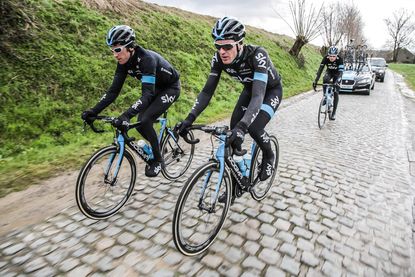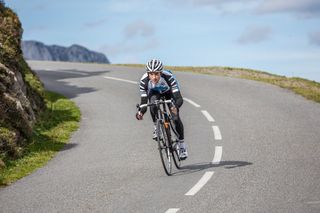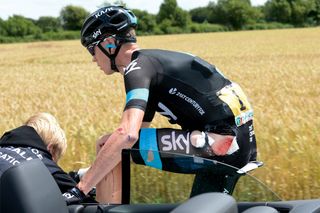Should you really train like a pro?
Busy work and family lives will get in the way of your riding. Vicky Ware takes a look at five real world ways that you can mimic the pro lifestyle

Watching pros battle for glory in your favourite race can make you want to emulate whatever it is they’re doing to go so fast. How many hours a week do they train? What are they doing in training that has made them so much faster than us mere mortals?
>>> Detraining: The truth about losing fitness
With a very different lifestyle to a full-time athlete, is it possible to train like a pro? There are certainly lots of lessons amateurs can take from the way professional cyclists train, but copying exactly what they do is likely to lead to exhaustion rather than speed. A direct translation from pro training to the life of someone with a full-time job isn’t a good idea if you want to get fast, but there are some features that can be taken from pro life to improve your cycling prowess.
Focus

Steven Gallagher, Director of Dig Deep Coaching, is an ex-pro with seven years of experience in the pro peloton and now coaching amateur riders, giving him a great perspective on how pros train v what amateurs tend to do.
“What pros have done for years and something I learned from my time racing as a professional is that you need to narrow down the focus of the training to that which will help you reach your aims the best way possible,” says Gallagher.
>>> Tinkoff-Saxo chef Hannah Grant explains what it takes to fuel a pro rider
This is something many people fail to do. Sitting down at the beginning of a training block and deciding what it is you want to achieve in cycling, with focus on long and short-term goals, is one aspect of training that often gets pushed to one side.
Get The Leadout Newsletter
The latest race content, interviews, features, reviews and expert buying guides, direct to your inbox!
Don't let your office sap your fitness
Now, as the season draws to an end is a good time to do this if you haven’t already. The goal is the end destination and from there you work out the steps you need to take to reach it, and how long the journey will take.
Your end goal might be to be a world champion but you will need to make stops at other destinations along the way; regional champion, and national champion are all stepping-stone goals to the big one.
>>> How gut health affects cycling performance
However without any goal at all you are likely to flail around aimlessly, possibly you will still be getting fitter and faster but with no real way of measuring whether you have achieved anything or not.
Personalised training

“The amount of hours, rest and intensity required in training is different from person to person, but making it specific to you is what I believe to be training like a pro — probably best put as the ‘ethos of training like a pro’,” explains Gallagher.
When you think of training like a pro in these terms, it is very much something an amateur should be focusing on, “making your training specific and personal to you [is] for sure [how] people with full-time jobs, families, busy lifestyles should train — in fact it can be more applicable to those people with less time to give to training as nothing can be wasted if wanting to maximise each session.”
>>> Find your perfect pace to optimise cycling performance
As an amateur you can’t train like a pro, but neither can you train like your club-mate or ride buddy; the only effective training is the one that is right for you.
While it’s not advisable to hunt your favourite pro down on Strava and copy every ride they do while also trying to hold down a full-time job and spend time with family, there are certainly aspects of pro life that you can bring to your own training.
Making sure your training is specific to you, getting adequate rest and being realistic with a long-term view can ensure you’re on track to achieve your cycling goals.
How good is your core?
Five ways you can train like a pro
1) Ditch the junk miles
What are the key things that can be taken from the way professional cyclists train? Gallagher thinks, “The first thing I think amateurs can learn from pros is that you are either ‘training’ i.e. doing a session that is progressing or enhancing your fitness or technique, or you are ‘recovering’ i.e. getting adequate rest that will allow you to hit the next training session 100 per cent.
“I have found that many amateurs do too much riding in-between these two intensities which is neither making training hard enough to make good progress or doing it easy enough to aid recovery or stimulate adaptations by resting.”
>>> The natural foods you need for top performance and recovery (video)
Make sure your training is truly polarised; make the hard sessions hard and the easy sessions easy. You’ll need a heart-rate monitor or power meter, and an understanding of training zones to maximise what you are trying to achieve.
2) Planning ahead
When planning your year in training, don’t just go with a traditional cycling season of trying to be on-form from April to September. For a pro rider their entire year is based around their season goals.
If focussing on the Tour de France, the year is broken up into blocks of training counting back from the start date of the race. Key races are scheduled in to test their fitness against others and get exposure to the intense efforts that can’t be replicated in training.
Find a training plan that suits you

Credit: Cycling Active
Cycling training plans: for beginners, intermediates and racers
Get into cycling, get fitter, or ride faster with our cycling training plans
This is the ideal way to plan your year so that you peak for the goal that is most important to you rather than being middling fit all summer.
But does this routine fit with your life? Do you have a job that is most stressful at a certain time of year, for example? If so, you would be wise to take that into account when planning both your training and your goal event.
3) Sacrifice
How many sacrifices are you willing to make to get faster? The life of a pro isn’t all glamour, when not racing or riding their bikes their time is taken up looking after themselves with stretching, massages and eating well.
Are you willing to forgo your Friday night out for an early night with a protein shake? Be realistic about what you’re willing to give up. If you’re not a pro, cycling is for fun so making your entire life purgatory to achieve your goals may not be worth it.
>>> Can amateur cyclists benefit from blood analysis?
On the other hand, maybe you’re willing to forgo some aspects of your social life for a period to see how fast you can get. Really thinking about where your priorities lie and what your goals are will help you get the most from your training.
While being disciplined and cramming in training sessions might feel like the right thing to do you can end up training less effectively because you are tired and rushed. Sacrificing recovery time, time with friends and family could mean you end up with worse results, even if these sacrifices are made with the best of intentions.
>>> How to tell whether you are overtraining, and how to avoid it
Being unrealistic with how much time you have to train can lead to disappointment when you don’t fit in the training you hoped to do and exhaustion if you fit it in at the expense of adequate recovery.
This isn’t something a pro would do. They know how much training and racing is going to take out of them physically and mentally and they don’t expect to race well if they’re training to the point of exhaustion.
This is another area where targeted, specific training can make all the difference and reduce the number of hours you spend on the bike each week and more importantly maximising the ratio between hours you spend on the bike and the amount you improve.
“Making the training specific to you and your goals is something we try to reflect in our coaching with individuals and we have seen great results,” explains Gallagher, “This does not mean a person with a full-time job or busy family needs to sacrifice other aspects of life to better their cycling but they can make training more specific and targeted.”
Don't let your training go to waste
4) Off-season down time
Although pros probably spend many more hours in the saddle than you, they also have a lot more time to recover. Your responsibilities off the bike are likely greater and spread over different aspects of life, meaning you need to make recovery a priority, even if you’re training for fewer hours.
If you’ve had a busier summer than you would have liked with work, and not done as much training as you planned, it might be tempting to head straight into winter training without taking an end of season break.
Psychologically, this period is important to rest, reboot and reflect on where you’ve been and where you want to go.
>>> Improve your core with these cycling specific sequences (video)
“The factors of work/family balance are crucial when judging post season fatigue and length of time off. A coach would work with an individual to make sure this is done correctly,” Gallagher advises.
“Taking a rest post-season can be beneficial for a number of reasons that include the mental side; motivation and enthusiasm can be low at the end of a long season so it helps to recharge this,” says Gallagher.
This isn’t an excuse to have two months off, though. “Taking a long break of non-activity post-season, i.e. three to four weeks, I think is not necessary or desirable,” explains Gallagher, “both for pros and amateurs. One to two weeks of rest and then a number of weeks of varied activity to keep the body moving is best before starting the winter training in earnest.”
Training zones explained
5) Support team
One aspect of pro life is having team mechanics and soigneurs to deal with all the stuff around riding a bike like washing kit and cleaning chains. For the rest of us we have to be our own support team.
Ensuring you have a good relationship with your local bike shop can go a long way to improving this aspect of non-pro life. Book in a service before key events so you aren’t blowing hard-won fitness by riding a badly maintained bike. Integrate regular bike maintenance into the number of hours you have to train each week.
Is the 10 hours you’ve set aside for training a realistic number, or have you actually got 10 hours including kit change, bike washing, bike maintenance and all the other stuff that goes around riding a bike?
>>> How to adjust your bike gears (video)
To avoid frustration it might be better to plan for eight to nine hours of training, for example, and have a set one hour each week or fortnight when you know you’ll be doing bike maintenance.
If it doesn’t need doing you’ll have a bonus hour to ride or recover.
Having your bike regularly maintained by an experienced mechanic at your local bike shop also means you will never have to spend four hours when you could have been training (it will be sunny on the day your bike breaks) trying to work out how to change a bottom bracket from a YouTube video.
What does it mean to you?

One issue with attempting to train like a pro is realising that everyone, even pros, has a different idea of what it means to do this.
“The term ‘training like a pro’ probably means something different from person to person but for me it means making your training specific, targeted and personalised,” explains Gallagher.
Rather than thinking in terms of hours or miles done by individual professional riders, it brings the focus back to the only person who can achieve your goals: you.
When not to train like a pro…

Injured – Pros will often continue to straight after a crash. With tailored medical support and a need to not lose fitness, they can afford to. It’s different as an amateur. Take some time off and get proper rest. You’ll heal quicker.
Motorpacing – There’s a lot of skill in motorpacing, and UK roads aren’t particularly suitable. It’s also far more specific to the requirements of pro racing.
What makes a pro different from the rest of us?

Experience
One thing that many pros may have over amateurs is the fact they’ve been training froma very early age. While genes, temperament and upbringing come into play, one thing the pros all have in common is countless hours on the bike.
>>> Why amateurs shouldn’t try to pedal like Chris Froome
This doesn’t mean you should give up because you didn’t start 20 years ago, but bear in mind that the pros are only capable of riding 30 hours a week because they’ve been doing it for years. A popular and often quoted research paper suggests it takes 10,000 hours of practice to become proficient at something. While most pro riders started as children, it’s good to know that if you started cycling late in life, you have plenty of improvement still to come!
In it for the long haul
Pros also tend to have a more long-term view of training and racing which affects their day to day decision making. Panic training, something most amateurs succumb to at some point is unlikely to happen to a pro-rider. They don’t panic and attempt to become world-class in a three-week training block. They are well aware from years of experience that it’s not actually possible.
Having some perspective on the big picture allows you to take time off with injury or illness when you need to in the knowledge that you can steadily regain your previous fitness levels. Keep your long-term goals in mind and realise a day off to shake off a cold now could save you three weeks off later.
Not just pedal pushing
Pros know that improving isn’t just about hours spent training. Seeing a physiotherapist if you have aches and pains, getting a bike fit to ensure you and your bike are working optimally together and asking experts about areas such as stretching and general body maintenance are all part of the pro attitude to training. Training is their job, albeit a job they’re passionate about, and their body and health is their livelihood. They make sure everything is in place to allow them to do their work. It’s not just about putting the hours in, but about making sure those hours are effective.

Thank you for reading 20 articles this month* Join now for unlimited access
Enjoy your first month for just £1 / $1 / €1
*Read 5 free articles per month without a subscription

Join now for unlimited access
Try first month for just £1 / $1 / €1
-
 Lip service isn't good enough: here's what needs to change for cycling events to actually be inclusive
Lip service isn't good enough: here's what needs to change for cycling events to actually be inclusiveThese are the key actions that make an event actually inclusive and do more than just lip service.
By Marley Blonsky Published
-
 Ask a coach: ‘Should I cycle commute every day?’
Ask a coach: ‘Should I cycle commute every day?’The length of your commute is a major factor; but there are ways to adapt your routine to maximise on the gains of riding into work
By Alex Welburn Published